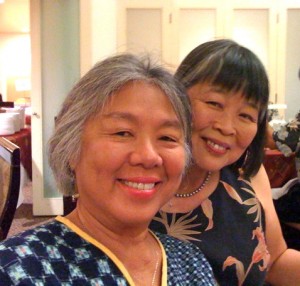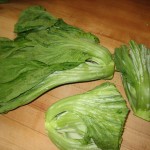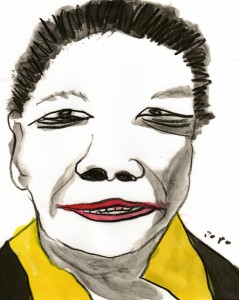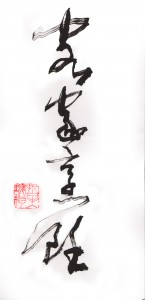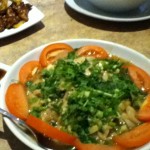
Susan Yan, Linda L. Anusasananan, and Martin Yan
A few days ago, my good friend Jerry DiVecchio hosted a book party for me. I worked with Jerry for more than three decades at Sunset Magazine. She taught me how to write and develop recipes, a skill that came in handy when writing a cookbook.
We invited a lot of old friends, many in the media, some from Sunset Magazine, and some fellow Les Dames members. Joyce Jue who wrote some generous words for the book jacket came. Martin Yan, who wrote the foreward for the book, and his wife Susan arrived during the latter half of the party. With his busy travel schedule and the opening of his new restaurant, M.Y. China, I’m lucky he could attend.
Jerry suggested I cook several recipes from the cookbook for the party. What do you serve to celebrity chef Martin Yan? I struggled with the menu, because it had to meet so many criteria. The menu needed to be no maintenance, meaning I didn’t have the time to fuss with the food during the party. I had to make the food completely ahead and transport it. The food had to hold up for a few hours. Preferably there would be little last minute cooking. We scheduled the party during dinner hours, so it needed some substance. We expected about forty people. This is what I came up with. Follow along with your cookbooks.
Hakka Walk-Around Party for 30 to 40
Pickled Mustard Greens and Pickled Cucumbers (p. 147, double recipes)
Pickled Carrots and Radishes (p. 60, double recipe)
Garlic-Chile Eggplant Sticks (p. 56, double recipe)
Chef Soon’s Pork Belly with Preserved Mustard Greens (p. 45, optional)
Steeped Chicken Breast (p. 22, cooked 3 lb. chicken) with Fresh Ginger-Onion Sauce (p. 66, triple recipe) in Lettuce Leaves or on a bed of shredded Chinese Cabbage
Hakka Pork Sliders (adapted from Steamed Black Bean Pork p. 165, slider recipe follows)
Sesame Cookies (purchased) and Orange Wedges
The Game Plan:
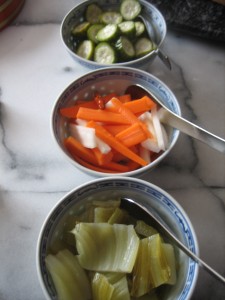
Pickled cucumbers, radishes and carrots, and mustard greens
The pickles could be made several days ahead. The eggplant could be also made a day ahead; allow to warm to room temperature for serving. Shortly before serving, sprinkle with cilantro. I had some pickled red chiles and sprinkled them over the top for a pop of color; you could also use chopped red bell pepper.
The pork belly is not essential, but I had food professionals as guests, so I aimed to impress. It takes time to make so I spread the work over several days. I steamed it completely the day before the party, then reheated it in the steamer until hot in center, 30 to 45 minutes, at the party site. If you were doing the party at home, you can also just assemble the dish ahead, then steam a couple of hours before serving. This dish needs to be served hot so set it on a warming tray. Serve with sliced small buns or rolls for sandwiches, if desired.
I cooked and shredded the chicken and made the ginger-onion sauce a day ahead. The morning of the party, wash and crisp the lettuce leaves as directed on p. 201. Mix the chicken with the zesty ginger sauce. However, for the next party, I skipped the lettuce cups and placed the chicken on a bed of shredded Chinese cabbage or lettuce.
The sliders were adapted from Steamed Pork with Black Beans (p. 165). Since I needed to keep it hot for a few hours, I thought a crock pot would be the perfect solution. I doubled the recipe and cooked it in the slow cooker for 3 to 3 1/2 hours. It worked beautifully. You can cook it up to 3 days ahead, cool, remove fat, transfer to smaller containers, cover and chill. Reheat the meat in the slow cooker, covered over high heat until hot and bubbly, 1 1/2 to 2 hours. Then reduce heat to warm setting. Serve with split baked rolls and people can assemble their sliders throughout the party.
Hakka Pork Sliders
Follow recipe for Steamed Black Bean Pork (p. 165) except double the ingredients, Cut the pork into about 3-inch chunks and brown meat, in batches, if needed. Transfer the meat to a 6-quart slow-cooker. Add the black bean mixture to pan and 1 cup water and bring to a boil. Pour black bean mixture over pork. Cover the slow-cooker and cook at high heat until very tender when pierced, 3 to 3 1/2 hours. Skim off and discard fat. With forks, break pork into coarse shreds or chunks. Serve in small baked rolls. Makes 5 to 6 dozen small sandwiches.
 The Hakka Cookbook is one month old. Since the book has been released, several reviews have appeared in the past month. Here’s a brief summary. For the whole line-up of press coverage, check the media page.
The Hakka Cookbook is one month old. Since the book has been released, several reviews have appeared in the past month. Here’s a brief summary. For the whole line-up of press coverage, check the media page.



